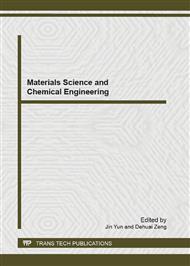[1]
Watt, J.A., Bone, S., Pressler, M., Cranston, H.J., Paden, C.M., "Ciliary neurotrophic factor is expressed in the magnocellular neurosecretory systemof the rat in vivo: Evidence for injury- and activity-induced upregulation, " Exp. Neurol, vol.197, no.1, Jan 2006,pp.206-214.
DOI: 10.1016/j.expneurol.2005.09.009
Google Scholar
[2]
Liu, QS., Wang, QJ., Du, GH., Zhu, SY, Gao M, Zhang L., Zhu, JM., Cao, JF. "Recombinant human ciliary neurotrophic factor reduces weight partly by regulating nuclear respiratory factor 1 and mitochondrial transcription factor A," Eropean Journal of Pharmacology, vol.563, no.1-3 ,Jun, 2007, pp.77-82
DOI: 10.1016/j.ejphar.2007.02.034
Google Scholar
[3]
Kelleher, M.O., Myles, L.M., Al-Abri, R.K., Glasby, M.A. "The use of ciliary neurotrophic factor to promote recovery after peripheral nerve injury by delivering it at the site of the cell body," Acta Neurochir. (Wien) , vol 148, no.1, Jan 2006, p.55–61.
DOI: 10.1007/s00701-005-0631-2
Google Scholar
[4]
Macrae, I.M. " New models of focal cerebral ischemia. Br," Clin. Pharmacol, vol34, no.4, Oct 1992, p.302–308.
Google Scholar
[5]
Zea Longa, E.L., Weinstein, P.R., Carlson, S., Cummins, R. "Reversible middle cerebral artery occlusion without craniectomy in the rats," Stroke, vol20, no.1, Jan 1989,p.84–91
DOI: 10.1161/01.str.20.1.84
Google Scholar
[6]
Tu, Y., Kroener, S., Abernathy, K., Lapish, C., Seamans, J., Chandler L.J., Woodward, J.J. "Ethanol inhibits persistent activity in prefrontal cortical neurons.," Neurosci , vol 27, no.17, Apr 2007,p.4765–4775.
DOI: 10.1523/jneurosci.5378-06.2007
Google Scholar
[7]
Henne, W.M., Oomman, S., Attridge, J., Finckbone, V., Coates, P., Bliss, R., Strahlendorf, H., Strahlendorf, J. "AMPA-induced excitotoxicity increases nuclear levels of CAD, endonuclease G,and acinus and induces chromatin condensation in rat hippocampal pyramidal neurons," Cell Mol. Neurobiol, vol 26, no.3, May 2006, p.321–339.
DOI: 10.1007/s10571-006-9031-2
Google Scholar
[8]
Ban, J.Y., Jeon, S.Y., Nguyen, T.T., Bae, K., Song, K.S., Seong, Y.H.. "Neuroprotective effect of oxyresveratrol from Smilacis chinae rhizome on amyloid Beta protein (25–35)-induced neurotoxicity in cultured rat cortical neurons,"Biol Pharm Bull , vol 29, no.12, Dec 2006,p.2419–2424.
DOI: 10.1248/bpb.29.2419
Google Scholar
[9]
Rama Rao, K.V., Panickar, K.S., Jayakumar, A.R. Norenberg, M.D. "Astrocytes protect neurons from Ammonia toxicity," Neurochem. Res , vol 30, no.10, Oct 2005, p.1311–1318.
DOI: 10.1007/s11064-005-8803-2
Google Scholar
[10]
Liu, QS., Gao, M, Zhu SY, Li SJ, Zhang L, Wang QJ, Du GH.. "The novel mechanism of recombinant human ciliary neurotrophic factor on the anti-diabetes activity," Basic Clin Pharmacol Toxicol, vol.101, no.2, Aug 2007,pp.78-84.
DOI: 10.1111/j.1742-7843.2007.00092.x
Google Scholar
[11]
Jiang, R.G., Eyzaguirre, C.. "Effects of hypoxia and putative transmitters on [Ca2+]i of rat glomus cells," Brain Res, vol.91, no.10, May 2004, p.285–296
DOI: 10.1016/j.brainres.2003.09.075
Google Scholar
[12]
Rui Liu, Mei Gao, Zhi-Hong Yang, Guan-Hua Du. "Pinocembrin protects rat brain against oxidation and apoptosis induced by ischemia–reperfusion both in vivo and in vitro," Brain Research, vol.1216, no.24, Jun 2008,p.104–115.
DOI: 10.1016/j.brainres.2008.03.049
Google Scholar
[13]
Hwang, J.J., Choi, S.-Y., Koh, J.Y. "The role of NADPH oxidase, neuronal nitric oxide synthase and poly(ADP ribose) polymerase in oxidative neuronal death induced in cortical cultures by brain-derived neurotrophic factor and neurotrophin-4/5," J Neurochem, vol.82, no.4, Aug 2002, p.894–902.
DOI: 10.1046/j.1471-4159.2002.01040.x
Google Scholar
[14]
Honig, L.S., Rosenberg, R.N. "Apoptosis and neurologic disease," Am. J.Me , vol.108, no.4, March 2000, p.317–330.
Google Scholar


